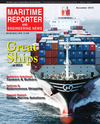
Page 19: of Maritime Reporter Magazine (December 2015)
Great Ships of 2015
Read this page in Pdf, Flash or Html5 edition of December 2015 Maritime Reporter Magazine
approved range of loading conditions; ment provides a solution that will make it and easy to demonstrate compliance with the • existing tankers provided with ap- damage stability requirements to the Port proved limiting KG/GM curves covering State authorities for any cargo or ballast all applicable intact and damage stability distribution.
requirements.
The Administration should take into ac- The Solution count the Guidelines for the approval of The use of an approved computer pro- stability instruments(MSC.1/Circ.1229) gram, to verify that the non-standard when reviewing them. loading condition complies with the dam-
Stability software should be approved, age stability requirements, can be readily but hardware approval is not mandatory applied to new ship loading computers or and can be covered by national standards. implemented as an upgrade to existing loading computer programs.
Commentary on Compliance Loading computer programs with this
Limiting the number of loading per- feature are generally referred to as “IACS mutations or range of loading is not a Type 3 Loading Instruments” as speci? ed practical operational restriction for many, in IACS URL 5 (applicable for new build- if not most, tank ships. Practical reliance ings since July 2005), which de? ne Type on gaining voyage speci? c approvals on 3 as “software calculating intact stability a timely basis may also be a burden to and damage stability by direct application both the operator as well as the national of preprogrammed damage cases for each administration, and may limit operational loading condition.” ? exibility. Herbert-ABS’ CargoMaxTM loading
Many ships are currently operating computer with the Direct Damage Stabil- effectively and safely, using approved ity (DDS) module fully meets the require- limiting KG/GM curves, covering all ap- ments of IACS URL 5, Type 3, for any plicable intact and damage stability re- type of tank vessel. It demonstrates com- quirements. For this type of system the pliance with the damage stability require- limiting KG (or required GM) curves ments for any of the relevant regulations vs. draft are pre-developed and pre-ap- from IMO and national administration for proved, and would typically be added to any type of loading or ballast loading. It both the Stability Booklet and the loading can also be used to demonstrate this com- computer. This would normally insure pliance to Port State inspectors or vetting compliance with both the damage stabili- surveyors.
ty and intact stability requirements. How- ever, in practice, these curves are compli- Pre-existing Onboard Software cated and expensive to produce, and also Loading computer software previously have other application and enforcement approved for stability can be classi? ed as concerns as noted in MSC 82/18/3, “be- one of three types as de? ned by IACS UR cause of the need to consider all possible L5: loading and damage combinations and any associated limiting provisions such • Type 1 software calculates intact as tank ? lling ratios. The resulting stabil- stability only through the use of an intact ity books may be complex and not easily required Max GM/ KG curve.
applied by ships’ of? cers and Port State • Type 2 software calculates intact control inspectors”. For these reasons stability and checks damage stability us-
Herbert-ABS Software Solutions LLC ing a combined intact and damage stabil- (Herbert-ABS), generally does not rec- ity required GM/Max KG curve.
ommend this approach. • Type 3 software calculates intact
The best practical solution is to ? t on- stability and damage stability by direct board damage stability veri? cation in- application of preprogrammed damage struments on all tank vessels as required. cases for each loading condition (DDS).
A direct damage stability loading instru- Determining which software type an ex- www.marinelink.com 19
MR #12 (18-25).indd 19 12/4/2015 11:31:20 AM

 18
18

 20
20
